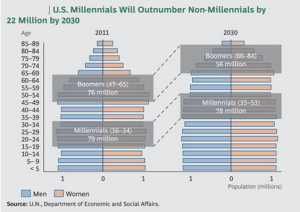“Hence the skillful fighter puts himself into a position which makes defeat impossible, and does not miss the moment for defeating the enemy.”
– Sun Tzu “The Art of War”
When it comes to positioning on the digital battlefield, are social media and online communities just another type of terrain that marketers need to adapt to? Or has the digital marketplace removed the need for Sun Tzu’s tactics altogether?
To get a good understanding of brand positioning, we take our wayback machine to 1969 when the pioneer of marketing theory, Jack Trout, first introduced his theory of brand positioning.
This was the Mad Men era where print, radio and television media reigned and every home had one phone and television; if you were lucky. Marketers looked for ways to make their brands step out from the crowd and win against their competitors and they did this by understanding their consumers and perfecting their brands “mix” (logo, price of the product, packaging, promotions and advertising).
In the last fifteen years the online world has changed all that. The old marketing tools of brand positioning are waning and no longer can businesses thrive by finding the right time and place to strike out to grab the casual consumer. Experts show that attention spans have dropped dramatically and even a one-second delay on a website can cause a 11% fewer page views.
Every day we are bombarded by videos, banners, emojis and sounds. Today, the average North American consumer is exposed to over 3000 brand messages a day, with pop-up and banner ads lurking in every corner of our screen. With that level of brand saturation, we’ve grown defiant of brands forcing themselves upon us. While we understand the need for sites to pay their bills and tolerate the occasional ad that interrupts our online adventures, that is a sentiment not being shared by younger consumers. As i’ve talked about in previous blogs, the internet is continually speeding up and consumers are resolute that their needs are far more important than an advertisers wants; and that these three rules should always be followed:
- Everyone wants to be heard.
- Everyone wants to be understood.
- Everyone wants his or her life to count.
Those three needs both define us as human beings and emphasize the changing demand modern brands now face. John Bonini, marketing director at IMPACT Branding & Design, explains the needs of the Millennials.
Millennials are the largest demographic in the United States and Canada.
This is the new direction of brand positioning on the digital frontier: knowing who you are and engaging in constant two-way communication to see what customer needs can be met on a day-by-day basis. After all, brands are no longer scouring the woods hunting down their chosen prey. Instead, they are laying out a trail of the sweetest candy so no matter where you stumble onto the internet trail, your searches will find that trail and bring the consumer back to them. Which makes knowing how your customers needs and how they perceive your brands position more important than it has ever been in the past. Like an actor finding a character, a modern brand must find the verb or short sentence that best represents their company’s unique values. Zappos values being “the online service leader” while Volkswagens verb of value is “Innovate“. Once you know this, then you know where your customers are. Zappos can market to those looking for exceptional service, while Volkswagen can aim to attract the innovators of the online community.
So how has this changed the definition of brand positioning? According to Ardath Albee‘s blog on the Power of Position in B2B Content Strategy, digital brand positioning can now defined as:
Engagement and trust, two words that lead me into the final area that has an impact on a brands digital positioning: the power of word of mouth. Word of mouth has become an important influence in the online marketplace. One angry voice can now overpower 1000 banner ads. The latest statistics emphasize the degree of power that a strong word of mouth has on how your brand is publicly viewed. By creating and engaging your community they are the cheapest way to grow the strength, and market share, of your company and your brand. The statistics show that the immense power the voice of the consumer has online today.
- 50% of purchase decisions are influenced by word-of-mouth.
- 1,000 customers can generate 500,000 conversations about a brand.
- 92% of consumers trust recommendations from friends and family more than any other form of advertising and just 10% trust brands today.
- 25% of search results for the world’s 20 largest brands are links to user-generated content published via social media.
So while I follow Sun Tzu’s teachings in my everyday life (a copy of The Art of War sits next to The Elements of Style on my work shelf), the facts show that the digital terrain warrants a different approach to the conventional warfare model market positioning was founded on. It is no longer viable to fight a war into the mind of the consumer through traditional brand positioning methods and expensive media campaigns. Instead, it is cheaper and more influential to open a dialogue with your consumers to get into their heart instead. Your brand position, no matter how small a company you are, will be stronger for it.
“Beat your plowshares into swords and your pruning hooks into spears. Let the weakling say, I am strong!”
– Joel 3:10 “The Holy Bible – New International Version”
Let me know what side of the equation you stand on. Swords or plowshares? Battle for the mind, or heart?

